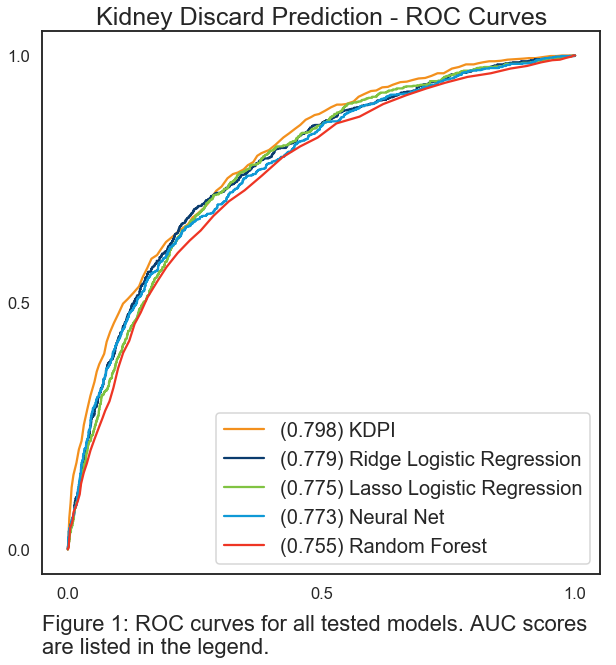Predicting Kidney Discards with Donor Admission Text
United Network for Organ Sharing, Richmond, VA
Meeting: 2019 American Transplant Congress
Abstract number: A203
Keywords: Allocation, Prediction models, Public policy
Session Information
Session Name: Poster Session A: Kidney Deceased Donor Allocation
Session Type: Poster Session
Date: Saturday, June 1, 2019
Session Time: 5:30pm-7:30pm
 Presentation Time: 5:30pm-7:30pm
Presentation Time: 5:30pm-7:30pm
Location: Hall C & D
*Purpose: Kidney discard rates have increased in part due to technological advancements and deceased donor policy updates that allow for recovery of organs at increased risk of failure. These changes induce both clinical and behavioral variability in utilization as physicians make riskier decisions. Accurately predicting whether a recovered organ will be discarded is thus an elusive goal but could profoundly increase utilization of high-risk kidneys via specialized or expedited placement.
Our hypothesis is that psycho-social data about the donor influences kidney acceptance decisions and therefore the likelihood it is eventually not utilized. Donor text entered by OPOs on DonorNet reflects clinical information and descriptive characterizations of the organs, donor, and context of donation; thus, capturing both clinical and behavioral factors. We propose using these donor texts as the basis for kidney discard models.
*Methods: Donor admission text and discarded kidney counts were collected for all deceased kidney donors from 2015 to 2017 (N = 26767; 100% have donor text entries). Standard machine learning models (listed in Figure 1) were fit on this dataset to an indicator representing if at least one kidney was discarded. The donor text was vectorized into model features using a term frequency times inverse document frequency (TF-IDF) weighting scheme.
For comparison, a simple KDPI-based model was used by associating higher KDPI with greater likelihood of discard.
*Results: ROC curves and areas under the curves (AUCs) are shown in Figure 1. The machine learning models generally underperformed relative to the KDPI model; the best AUC score of 0.798 was achieved by the KDPI model compared to 0.779 AUC from the ridge logistic regression model.
Spearman coefficients were calculated for all pairwise model combinations (Table 1).
*Conclusions: Although methods utilizing unstructured text data to model kidney discards were underpowered compared to a KDPI-based method, only a moderate correlation between the KDPI and text models was observed. This suggests donor text may be useful in augmenting traditional models based on structured clinical features.
| Lasso Logistic Regression | Ridge Logistic Regression | Random Forest | Neural Net | KDPI | |
| Lasso Logistic Regression | 1 | 0.926 | 0.840 | 0. 853 | 0.664 |
| Ridge Logistic Regression | 0.926 | 1 | 0. 849 | 0. 964 | 0. 673 |
| Random Forest | 0.840 | 0. 849 | 1 | 0. 792 | 0. 636 |
| Neural Net | 0. 853 | 0. 964 | 0. 792 | 1 | 0. 644 |
| KDPI | 0.664 | 0. 673 | 0. 636 | 0. 644 | 1 |
To cite this abstract in AMA style:
Placona A, Martinez C, Carrico B. Predicting Kidney Discards with Donor Admission Text [abstract]. Am J Transplant. 2019; 19 (suppl 3). https://atcmeetingabstracts.com/abstract/predicting-kidney-discards-with-donor-admission-text/. Accessed December 16, 2025.« Back to 2019 American Transplant Congress

